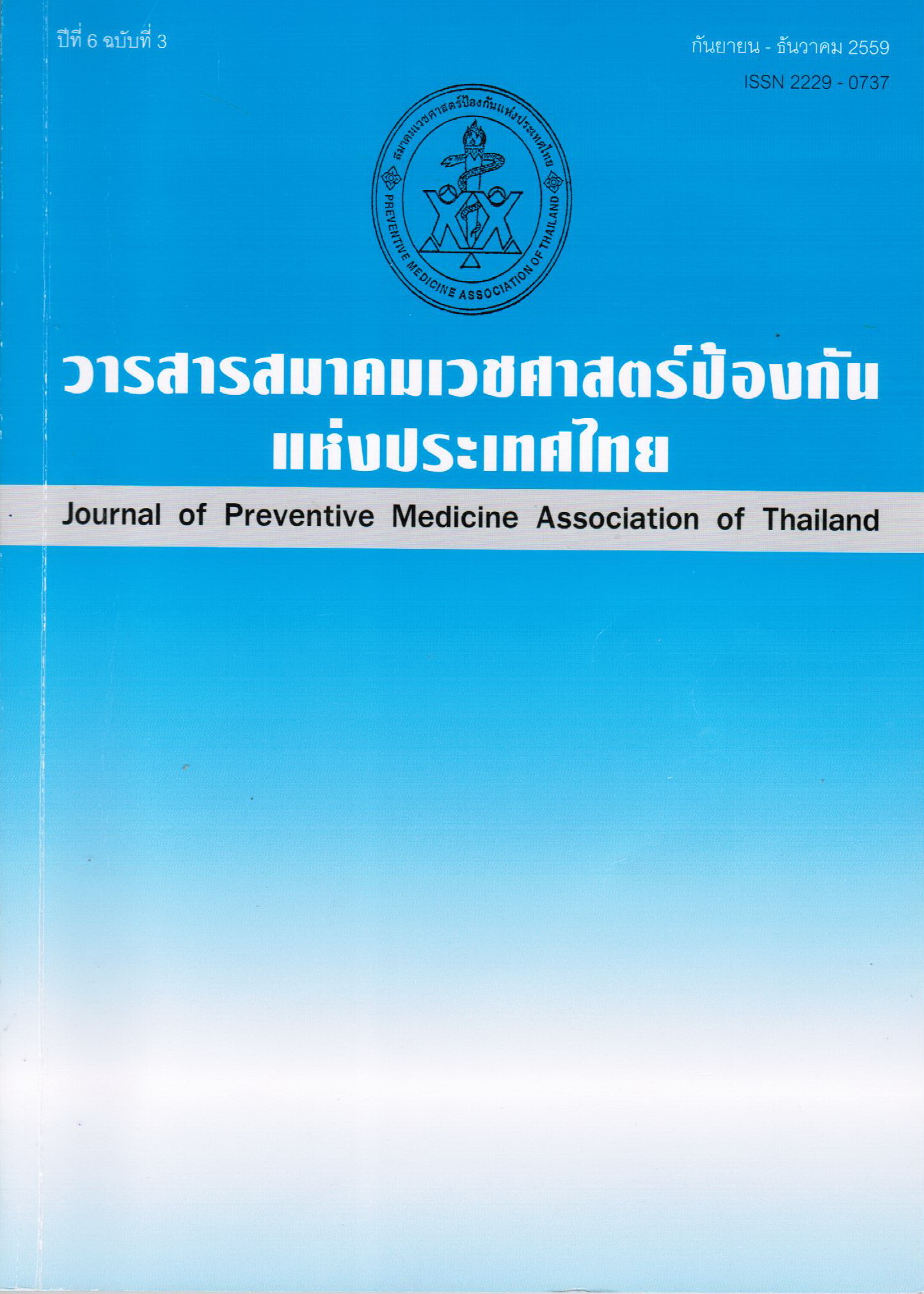รูปแบบการใช้สมาธิบำบัด SKT โดยครู ก เพื่อควบคุมความดันโลหิต ในผู้ป่วยโรคความดันโลหิตสูง จังหวัดยโสธร
คำสำคัญ:
สมาธิบำบัด แบบ SKT, ครู ก, ความดันโลหิตสูงบทคัดย่อ
ปัจจุบันโรคความดันโลหิตสูง ผู้ป่วยมีแนวโน้มของการไม่สามารถควบคุมระดับความดันโลหิตให้อยู่ในเกณฑ์ที่เหมาะสม มีจำนวนเพิ่มมากขึ้น ส่งผลให้เกิดภาวะแทรกซ้อนต่างๆ ตามมา แนวทางการควบคุมโรคความดันโลหิตสูงในปัจจุบันยังไม่สามารถลดปัญหาลงได้ เนื่องจากพฤติกรรมการปฏิบัติตัวของผู้ป่วยไม่ต่อเนื่องหรือสม่ำเสมอ หรือมีรูปแบบที่ไม่เหมาะสมกับวิถีชีวิตของผู้ป่วย ปัจจุบันมีการนำสมาธิบำบัด มาใช้ร่วมกับการรักษาด้วยยา ดังนั้น การศึกษาครั้งนี้จึงมีวัตถุประสงค์เพื่อ 1) พัฒนารูปแบบการใช้สมาธิบำบัด แบบ SKT โดยครู ก เพื่อควบคุมความดันโลหิตในผู้ป่วยโรคความดันโลหิตสูง จังหวัดยโสธร 2) เพื่อเปรียบเทียบ
ระดับความดันโลหิต BMI, Cholesterol LDL, Triglyceride และ Creatinine ของกลุ่มตัวอย่างก่อนและหลังดำเนินการ 3) เพื่อประเมินระดับความพึงพอใจในการปฏิบัติสมาธิบำบัดของกลุ่มตัวอย่าง รูปแบบการวิจัยเป็นการวิจัยและพัฒนา (R&D) ใช้ระยะเวลาศึกษาระหว่างเดือน พฤษภาคม-กรกฎาคม พ.ศ. 2558 กลุ่มตัวอย่าง ได้แก่ ผู้ป่วยความดันโลหิตสูงที่ไม่สามารถควบคุมระดับความดันโลหิตได้ จำนวน 36 คน เลือก กลุ่มตัวอย่างและพื้นที่การศึกษาแบบเจาะจงตามเงื่อนไข เครื่องมือที่ใช้ในการวิจัย เป็นครู ก ที่ผ่านการอบรมหลักสูตรสมาธิบำบัด SKT แบบสอบถาม ผลการตรวจทางห้องปฏิบัติการ เครื่องวัดความดันโลหิต และแบบบันทึกการปฏิบัติสมาธิบำบัดด้วยตนเองที่บ้าน ข้อมูลใช้โปรแกรมมาตรฐาน วิเคราะห์ โดยใช้สถิติเชิงพรรณนาและใช้สถิติ pair t-test ในการเปรียบเทียบค่าเฉลี่ยระดับความดันโลหิต BMI, Cholesterol, LDL, Triglyceride และ Creatinine ก่อนและหลังดำเนินการ ส่วนข้อมูลด้านคุณภาพวิเคราะห์ตามเนื้อหาวัตถุประสงค์ของการศึกษา
ผลการศึกษาพบว่า ข้อมูลทั่วไปของกลุ่มตัวอย่าง ส่วนใหญ่เป็นเพศหญิง ร้อยละ 55.6 อายุระหว่าง 46-60 ปี ร้อยละ 36.1 จบการศึกษาระดับประถมศึกษา ร้อยละ 61.1 ประกอบอาชีพเกษตรกรรม ร้อยละ 69.4 อยู่กันเป็นคู่ ร้อยละ 66.7 มีระยะเวลาที่เป็นโรคความดันโลหิตสูงอยู่ระหว่าง 1-5 ปี ร้อยละ 52.8 สภาพปัญหาของผู้ป่วยความดันโลหิตสูงควบคุมความดันโลหิตไม่ได้ ระดับความดันโลหิตสูง Systolic ส่วนใหญ่ ร้อยละ 88.9 อยู่ที่ระดับ 140-159 มิลลิเมตรปรอท ส่วน Diastolic ส่วนใหญ่ร้อยละ 94.4 อยู่ที่ระดับ 90-99 มิลลิเมตรปรอท รูปแบบการใช้สมาธิบำบัด แบบ SKT ในการควบคุมความดันโลหิตในผู้ป่วยโรคความดันโลหิตสูง มีการจัดอบรม ครู ก หลักสูตร 3 วัน โดย ครู ก นำไปสอนให้กับกลุ่มตัวอย่าง ตามมาตรฐานต้นแบบ SKT และให้ไปปฏิบัติต่อที่บ้านอีก 8 สัปดาห์ และได้รับการเยี่ยมติดตามจาก ครู ก ผลการปฏิบัติสมาธิบำบัด พบว่า มีการปฏิบัติสมาธิบำบัด สม่ำเสมอเป็นประจำ ร้อยละ 58.3 ปฏิบัติสมาธิ 2 ครั้งต่อวัน ร้อยละ 63.9 เวลาในการปฏิบัติส่วนใหญ่ ร้อยละ 36.1 ทำประมาณ 15-20 นาทีต่อครั้ง ท่าที่ปฏิบัติคือท่าที่ 1 กับท่าที่ 3 ร้อยละ 83.3 ส่วนใหญ่ร้อยละ 75.0 ทำในเวลาตื่นนอนหรือตอนเช้าตรู่ ร้อยละ 41.7 ได้รับการเยี่ยมบ้าน 3-4 ครั้ง ร้อยละ 58.3 คิดว่าสุขภาพดีขึ้นมาก ร้อยละ 86.1 มีความพึงพอใจต่อการปฏิบัติสมาธิบำบัด แบบ SKT ปัญหาและอุปสรรค์ในการปฏิบัติสมาธิบำบัด คือปฏิบัติไม่สม่ำเสมอ ปฏิบัติท่าเดียวเป็นส่วนใหญ่ ผลต่อโรค ส่วนใหญ่ยังไม่มั่นใจ ว่าจะไปช่วยลดความดันโลหิตสูงได้หรือไม่ แต่มีผลดีต่อสุขภาพร่างกายด้านอื่นๆ เช่น ระบบกล้ามเนื้อ ระบบทางเดินอาหาร การขับถ่าย การหลับนอน หรือผลต่อน้ำหนัก เป็นต้น เมื่อเปรียบเทียบค่าเฉลี่ยระดับความดันโลหิตค่า BMI, Cholesterol, LDL, Triglyceride และ Creatinine ก่อนและหลังดำาเนินการ พบว่า ระดับความดันโลหิต Systolic และ Diastolic, BMI, Cholesterol และ Creatinine หลังการฝึกสมาธิบำบัดแบบ SKT เมื่อสิ้นสุดการศึกษา มีค่าเฉลี่ยลดลงจากก่อนดำเนินการฝึกสมาธิ อย่างมีนัยสำคัญทางสถิติ (Mean Difference=22.56, 18.33, 0.61, 12.58 และ 0.12; 95% CI =18.98-26.13,15.74-20.92, 0.24-0.98, 4.07-21.09 และ 0.07-0.17;P-value <0.001, <0.001, 0.002, 0.005 และ <0.001 ตามลำดับ) ซึ่งจากผลการศึกษา ครู ก ต้องเป็นผู้มีประสบการณ์ที่ชำนาญและเชี่ยวชาญ ฝึกปฏิบัติให้เห็นผลอยู่สม่ำเสมอ การนำรูปแบบการใช้สมาธิบำบัดไปใช้ สถานบริการสาธารณสุข ควรเลือกผู้ป่วย ที่สมัครใจและชอบที่จะปฏิบัติสมาธิ ควรใช้การปฏิบัติสมาธิแบบ SKT เสริมร่วมกับวิธีการควบคุมระดับความดันโลหิตอื่นๆ รวมทั้งปรับรูปแบบการเยี่ยมบ้านเป็นแบบกลุ่ม เพื่อให้มีการพบปะ ส่งเสริมให้เกิดการรวมตัวเป็นกลุ่มขยายการปฏิบัติสมาธิ และนำไปใช้กับชีวิตประจำาวันทั้งคนปกติ หรือกับโรคอื่นๆ ต่อไป
เอกสารอ้างอิง
2. ราม รังสินธุ์, ปิยทัศน์ ทัศนาวิวัฒน์. การประเมินผลการดูแลผู้ป่วยโรคเบาหวานชนิดที่ 2 และความดันโลหิตสูงของโรงพยาบาลในสังกัดกระทรวงสาธารณสุขและโรงพยาบาลในสังกัด กรุงเทพมหานคร ประจำาปี 2555. (วันที่ค้นข้อมูล 1 มีนาคม 2558) แหล่งข้อมูล: URL:https://www.nhso.go.th/downloadfile/fund/CRCN_55/3.
3. กระทรวงสาธารณสุข กรมควบคุมโรค สำนักควบคุมโรคไม่ติดต่อ. รายงานประจำาปี 2558. กรุงเทพฯ:สำานักงานกิจการโรงพิมพ์องค์การสงเคราะห์ทหารผ่านศึกในพระบรมราชูปถัมภ์. 2559.
4. สำนักงานสาธารณสุขจังหวัดยโสธร. เอกสารสรุปผลการตรวจราชการและนิเทศงาน ครั้งที่ 2 กรณีปกติ เดือนกรกฎาคม 2557. ยโสธร: สำานักงานสาธารณสุขจังหวัดยโสธร;2557.หน้า 56-59.
5. ภัสราวลัย ศิติสาร, อรุณวรรณ สุวรรณรัตน์, จารุวรรณ ใจลังกา. ปัจจัยที่มีผลต่อพฤติกรรมการดูแลตนเองของผู้ป่วยภาวะความดันโลหิตสูงที่ควบคุมไม่ได้โรงพยาบาลดอกคำใต้ อำเภอดอกคำใต้ จังหวัดพะเยา. วารสารสาธารณสุขล้านนา 2556; 9(2): 120-121.
6. อุไรวรรณ พานิชเจริญผล. ผลของการฝึกสมาธิแบบอานาปานสติและการให้คำปรึกษากลุ่มที่มีต่อความเครียดของพนักงานหญิงโรงงานอุตสาหกรรม. (วิทยานิพนธ์ปริญญาวิทยาศาสตรมหาบัณฑิต). สาขาจิตวิทยาการให้คำปรึกษา. บัณฑิตวิทยาลัย.ชลบุรี:มหาวิทยาลัยบูรพา;2546.
7. อัจฉรา สคุนธสรรพ์, สุภาพ ใบแก้ว, มยุลี สำราญญาติ. รายงานการวิจัยเรื่องผลการฝึกวิปัสสนาสมาธิต่อการตอบสนองภาวะเครียดและความดันโลหิตของผู้ป่วยความดันโลหิตสูง. เชียงใหม่: คณะพยาบาลศาสตร์ มหาวิทยาลัยเชียงใหม่; 2542.
8. กัญญา แซ่เตียว. ประสิทธิผลอานาปานสติในการลดความเครียดและความดันโลหิตในผู้ป่วยโรคความดันโลหิตสูง กรณีศึกษาศูนย์สุขภาพชุมชน ตำบลทุ่งมน อำเภอปราสาท จังหวัดสุรินทร์. (วิทยานิพนธ์ปริญญาพุทธศาสตรมหาบัณฑิต). สาขาวิชาพุทธศาสตร์และและศิลปะแห่งชีวิต. บัณฑิตวิทยาลัย. กรุงเทพฯ:มหาวิทยาลัยมหาจุฬาลงกรณราชวิทยาลัย;2552.
9. สมพร กันทรดุษฎี เตรียมชัยศรี. การปฏิบัติสมาธิเพื่อการเยียวยาสุขภาพ. กรุงเทพฯ:สามเจริญพาณิชย์;2552.
10. จมาภรณ์ ใจภักดี, กมล อุดล, ปรารถนา สถิตวิภาวี, พนม เกตุมาน. ผลของการฝึกหายใจแบบลึกร่วมกับการผ่อนคลายกล้ามเนื้อต่อระดับความดันโลหิตและความเครียดในผู้ป่วยความดันโลหิตสูง. Graduate Research Conference 2014; 1641-1649.
ดาวน์โหลด
เผยแพร่แล้ว
รูปแบบการอ้างอิง
ฉบับ
ประเภทบทความ
สัญญาอนุญาต
บทความที่ลงพิมพ์ในวารสารเวชศาสตร์ป้องกันแห่งประเทศไทย ถือเป็นผลงานวิชาการ งานวิจัย วิเคราะห์ วิจารณ์ ตลอดจนเป็นความเห็นส่วนตัวของผู้นิพนธ์ กองบรรณาธิการไม่จำเป็นต้องเห็นด้วยเสมอไป และผู้นิพนธ์จะต้องรับผิดชอบต่อบทความของตนเอง






